In the previous article, a considerable section was devoted to ZX Spectrum and its clones, which literally flooded the USSR and did not give up positions until the mid-90s, when IBM-compatible computers became available to the average buyer. This time we will try to consider the history of this computer more seriously, including from the point of view of becoming a runet.

The history of the ZX Spectrum is complex and multifaceted. Moreover, it cannot be said that it has ended, and this weak by today's standards 8-bit computer is a thing of the past.
The brainchild of Clive Sinclair, a training computer based on the Zilog Z80 processor, which can now be found in almost any more or less smart piece of iron from the 1980-1990s - Game Boy, phones with AON, household appliances - has scattered around the world and formed almost not a separate culture, the generation of Speccy. Nevertheless, our story will begin with earlier events, which served as a kind of starting point in the journey of the Spectrum to the USSR.
Build the computer yourself

Here is a clipping from the journal "Radio" from 1986, issue number 4. It was the first time an article was published on the assembly of the Radio 86RK home computer. We strongly recommend that you read at least the preface to the article from the publisher.
It was assumed that readers of the magazine would be able to assemble, debug and start this computer on their own, having acquired all the necessary components in the radio parts store. In total, assembly required 29 microcircuits - very affordable even in small cities.
The computer was based on the processor KR580VM80A, a clone of Intel i8080A with a clock frequency of 1.78 MHz. At the same time, the actual speed of the computer, depending on the video mode used (25, 30, 50 visible lines), varied from 1.31 MHz to 700 kHz effective clock cycle.
Absolutely insignificant frequencies by modern standards. At the same time, the computer was pseudographic - to display games, combinations of text characters were used.
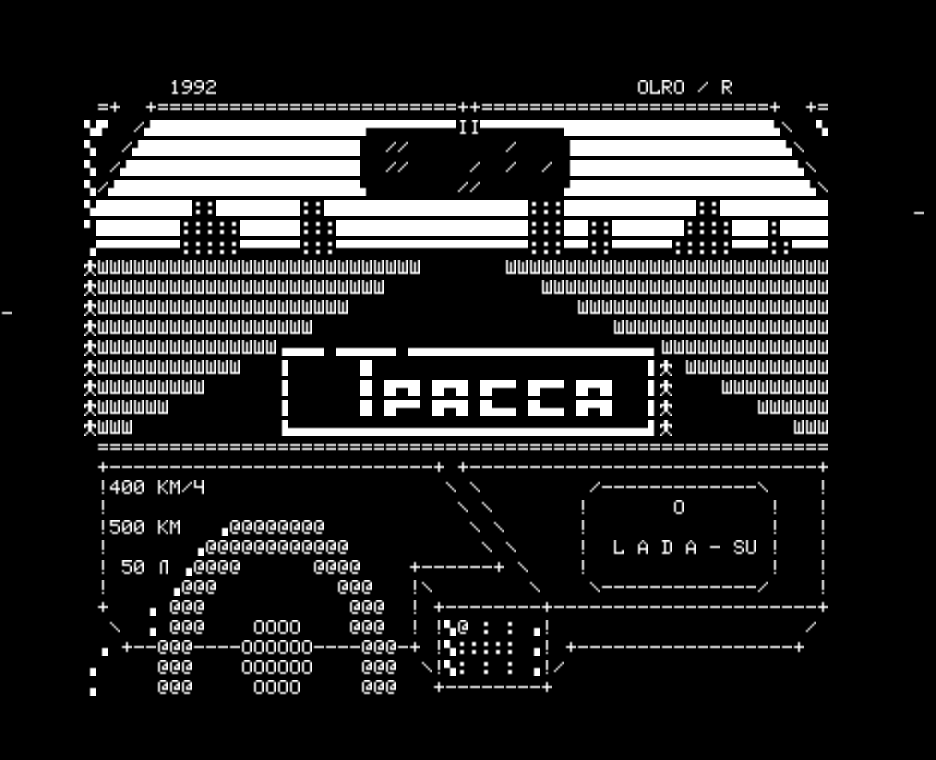
/ Game for Radio 86RK, rk86.ru
RAM was only 16 KB with a ceiling increase to 32 KB "second floor" chips. The firmware fit in a 2 KB ROM (expandable to 4 KB).
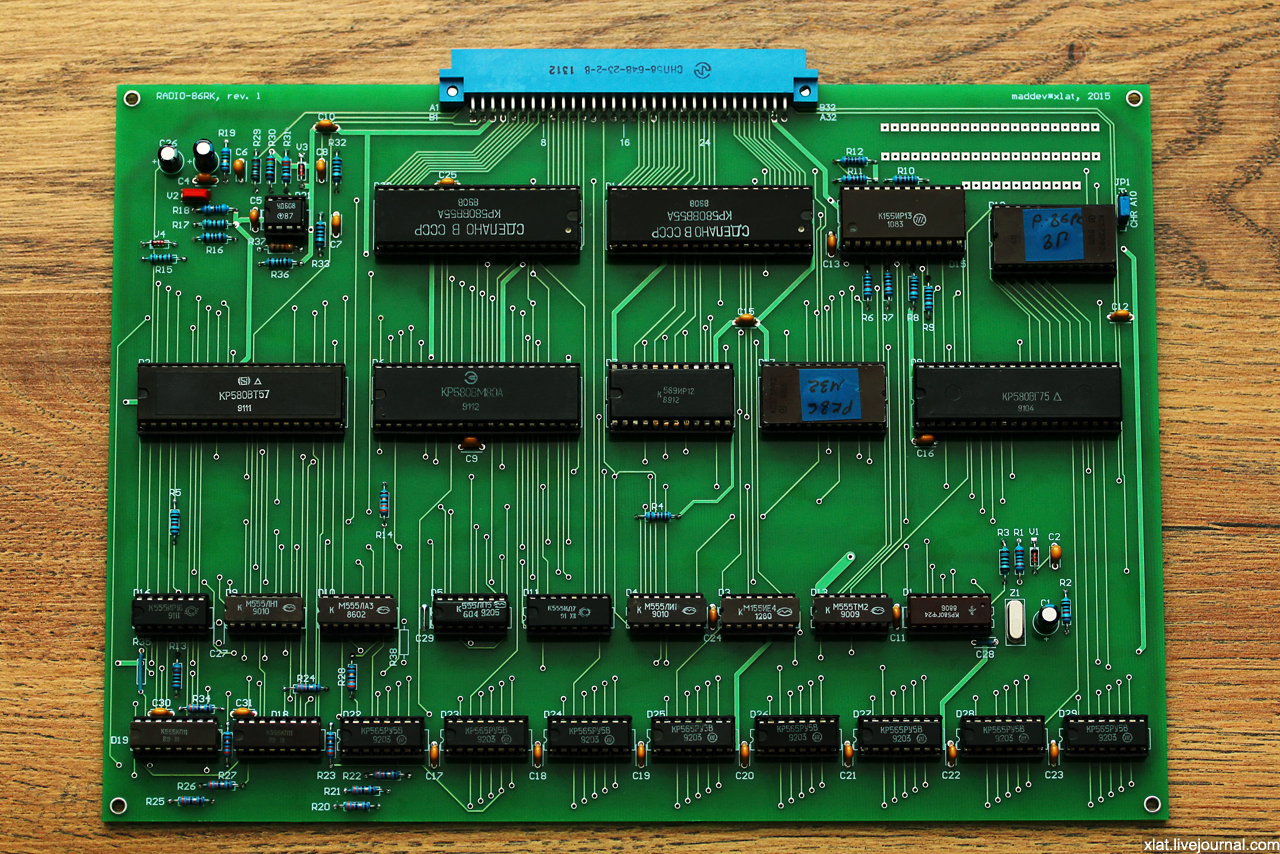
/ The collected board "Radio-86RK", xlat.livejournal.com
If you are interested in all the features and improvements of the original “Radio-86RK”, you can read about it here and reinforce the theory with numerous videos on YouTube, where enthusiasts demonstrate the real work of the computer.
But what is the connection between the Soviet amateur computer and Speccy? We will talk about this a little later, going through the history of the original ZX Spectrum.
Sinclair Research and its role in the Soviet computer revolution
The original car appeared in the UK 4 years earlier, in April 1982, and literally immediately won the attention of consumers throughout Europe.
The most budget version of the original Spectrum with 16 kilobytes of RAM cost only £ 125 at the start, while the price tag of the main 8-bit computer competitors was an order of magnitude higher. For example, the legendary Commodore 64 was already on sale for $ 595. Even without a transfer from one currency to another, it becomes clear that the Spectrum won this battle. But at what cost?
As you know, it is impossible to create something budgetary from high-class materials and components. Clive Sinclair, the founder of Sinclair Research, was completely unafraid. He initially did not want to create a powerful computer for everyday tasks. True, a bit later, Sinclair QL did release, bugs and poor software for which they were interested in programming the young Linus Torvalds.
The Spectrum was positioned almost as a training machine for children from 12 years old. Hence the main marketing advantages: low cost, compactness, minimal equipment and the ability to expand functionality through additional devices. In the 16K Spectrum ROM, the firmware was written, which included the basic dialect (Sinclair basic) and provided a simple user interface, the functionality of which could vary depending on the version of the computer.
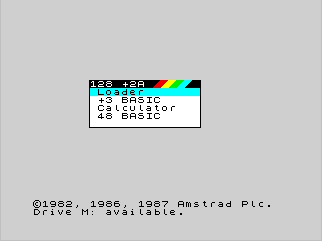
/ Screenshot of the “start menu” of the Amstrad version of the ZX Spectrum, sinclair.comboios.info
The Spectrum was produced by Sinclair Research from 1982 to 1986. Then the rights were transferred to Amstrad, but
Back to the product from Sinclair Research. The first models, the cheapest and simplest, were a rectangular box of black. On the top there was a rubber keyboard, on the back there were audio and video connectors, a power socket and slots for connecting peripherals.
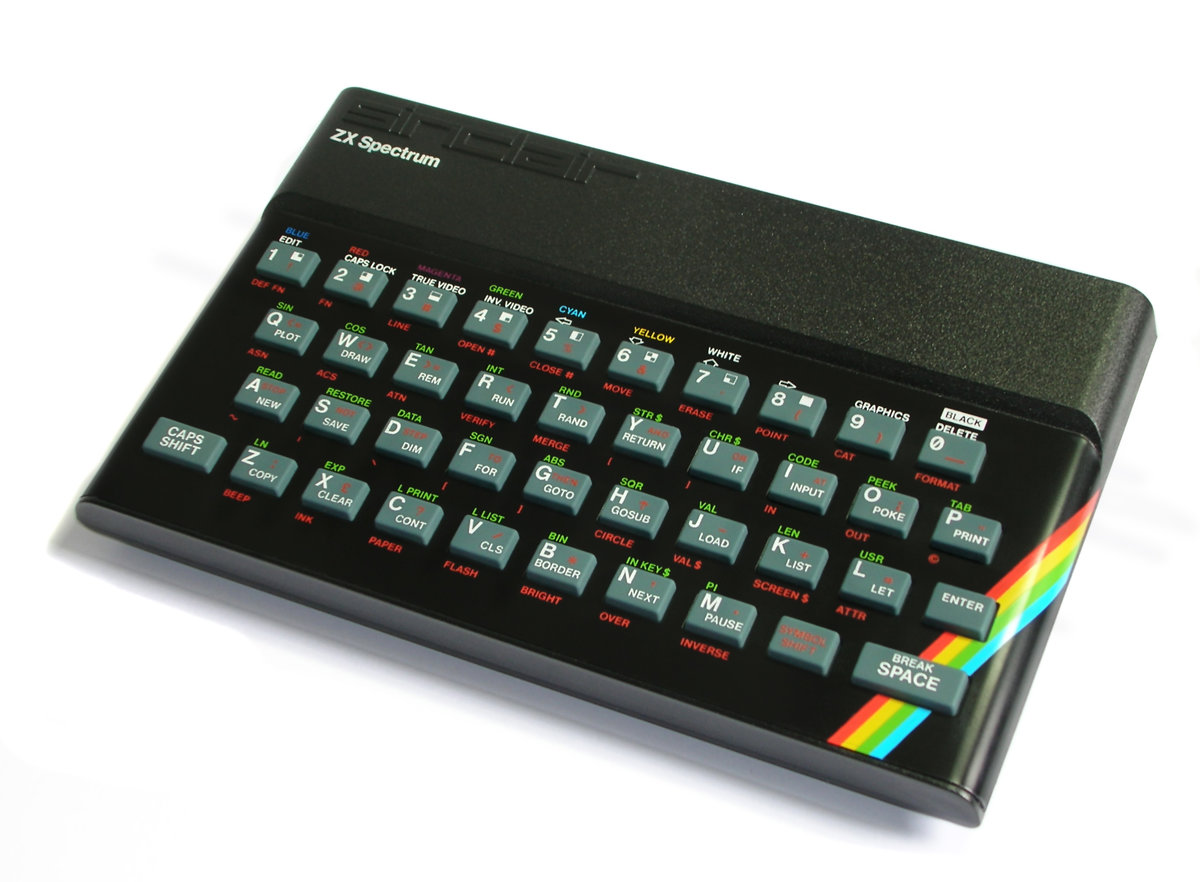
/ 48K ZX Spectrum
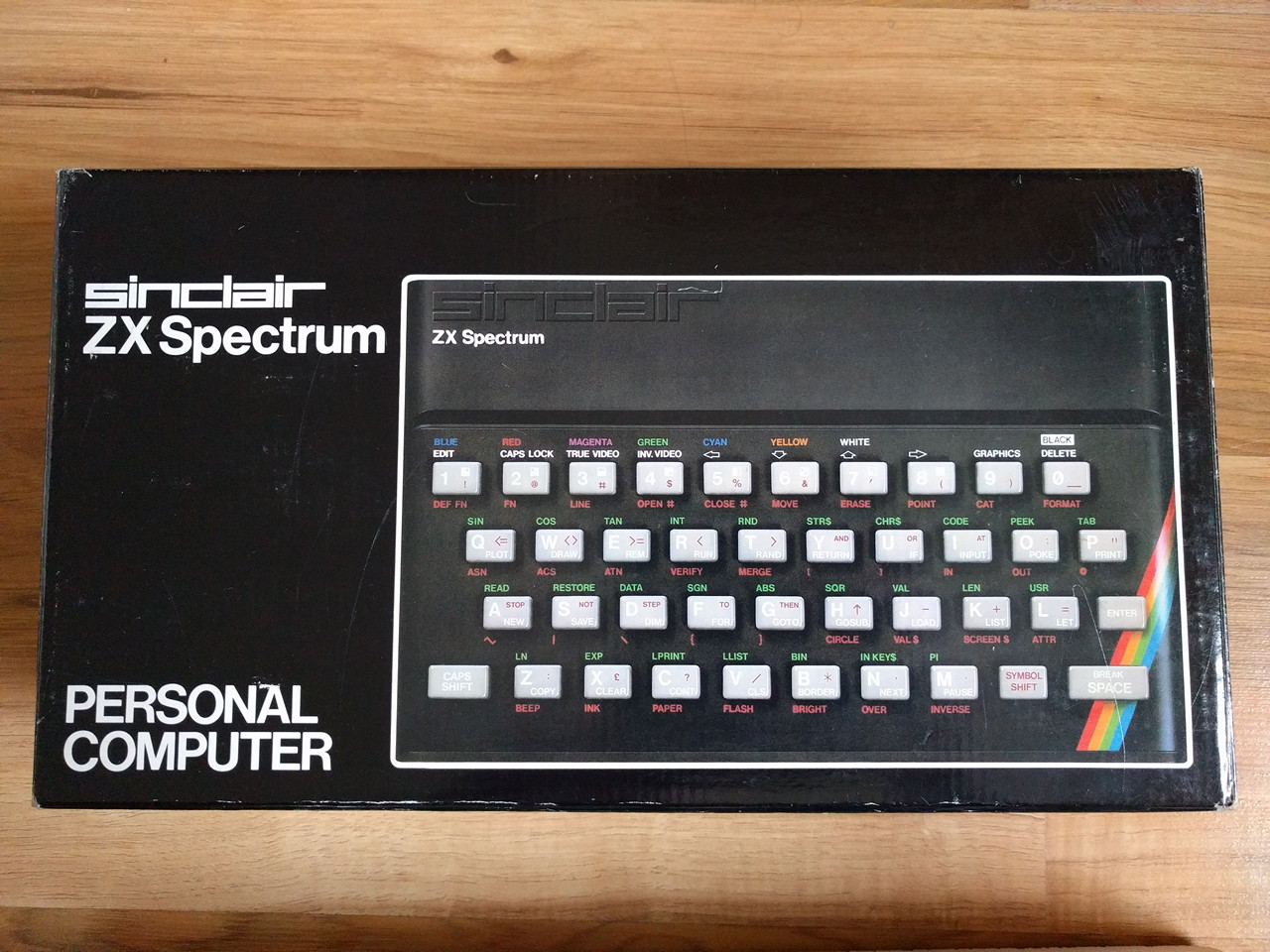
/ A subject was delivered in such a box
Spectrum keyboard deserves special attention: each of the 40 buttons, depending on the input mode, can perform different functions. The user could enable the desired input mode by pressing the Symbol Shift and Caps Shift modifier keys. Depending on the selected mode, the cursor could change to Latin letters L, C, K, E and G, which, in turn, meant the following:
- L - enter lowercase letters
- C - capitalization
- K - entering BASIC keywords
- E - enter additional keywords and operators
- G - input pseudographic, control characters and user-defined characters (UDG).
The Spectrum palette included 8 colors, 2 gradations of brightness for each (except black). The screen with a resolution of 256x192px was divided into familiarities with a length and height of 8px, while the color attributes were set to familiarities, not pixels. This means that pixels within the same familiarity could only be painted in 2 out of 15 colors. The INK attribute was responsible for the first color, and PAPER for the second color. In games, this caused the Spectrum's “proprietary” graphic artifact, kleshing (conflict of attributes) and became a stumbling block for many Spectrum fans and the main argument of computer opponents.

/ Example of clashing on ZX Spectrum, photo by vk.ru user Pixel King
Data entry into the computer could be through a tape recorder, by connecting external magnetic disk drives, and also using the ZX Microdrive device.
Thus, having fairly modest capabilities (by the mid-80s, Amiga 1000 and Atari ST entered the market), the Spectrum gained popularity and, without exaggeration, an army of fans and fans around the world. The most “advanced” model of the classic line can be considered the ZX Spectrum 128 “Toastrack” in 1986, which, as the name implies, had 128 KB of RAM, AY music co-processor and many other advantages.
The computer’s official life cycle ended in 1992, when the last “legal” model came off the assembly line. Sir Clive Sinclair himself in 1983, at the request of Margaret Thatcher, was awarded the title of “Knight of the Royal Order”. In 1986, he finally abandoned the production of computers. As you know, now Sinclair does not use the Internet and in general a computer, and prefers a telephone to email. Occasionally appearing on television, Sinclair expresses dissatisfaction with the fact that the ZX Spectrum has received and is receiving so much attention, because "programmers could direct their forces to something more useful." He believes that his "training" computer should have remained so. He has not played a single game made for the ZX Spectrum.
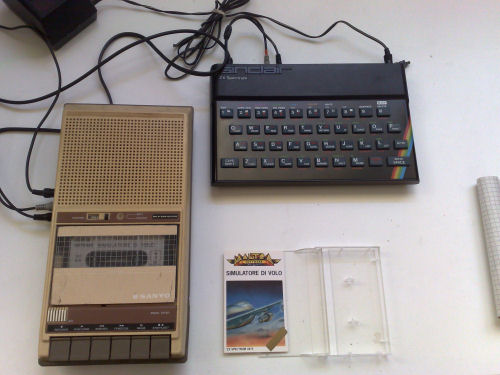
/ Config Spectrum gamer of the 80s: Spectrum, tape recorder and cassette with the game. The television was left overs. somethinggeeky.com
ZX Spectrum comes to the USSR
Just a few years after the release of the ZX Spectrum was able to successfully clone. And, unlike the Dolly sheep, many clones were not only viable, but also an order of magnitude more powerful than their parent.
The spektrumist community is divided into two camps: some “stoke” the originals from Sinclair, calling everything else “artisanal crafts,” others equally well relate to the originals and clones, preferring to use the latter. Nevertheless, the factory Spectrum in the USSR was negligible compared to "everything else." And in the lens of today's article is just “everything else”.
After 30 years, it is no longer possible to find out exactly how the ZX Spectrum got into our country. Presumably, the Spectrum was brought from Poland, since some of the documentation and the first software were in Polish.
Of course, engineers and programmers immediately wanted to create their own version of the Spectrum so that everyone could assemble it on an element base available in the USSR. However, there were two problems with cloning:
- Where to get the processors?
In the USSR, in addition to sex, there was also no Zilog Z80 and its analogues. Rather, the Z80 was, but it was quite expensive and it was not possible to replace it with something Soviet. Much later, in the 90s, our industry mastered the production of clones Z80, T34BM1 and KR1858BM1, but they worked an order of magnitude worse than the real ones.
- How to simulate ULA?
Most of the logic of the original computer was contained on a single chip, to steal the production technology of which at that time was not possible. Through trial, error, reverse engineering and even (possibly) sex, the work of the microcircuit was able to emulate on the Soviet element base. The structure and composition of the chipset varied from clone to clone.
So, in almost every "technically savvy" city of the USSR there was a clone. The most popular and more or less simple to assemble was Leningrad.
Now is the time to recall what we started the article with: it’s quite logical that following the question “how can a black-and-white Radio-PK86 compete with such a powerful beast?” The following question arose: “why, since I was able to make a RC, I not yet Spectrum? ".
For a Soviet man who was not spoiled by computer technology, the Spectrum looked like a revelation: chic music on the AY chip, hundreds of games on cassettes, the “just add a TV” connection model and much more in a matter of months made the ZX Spectrum a truly massive home computer in the country.
High-quality video with the assembly process, debugging and even some modernization of Leningrad can be seen here .
A little later, the production of clones was mastered by cooperators, and then state plants. The Soviet market was literally flooded with ZX Spectrum clones of varying degrees of quality, endowed with different capabilities.
As old Tolkien wrote (and Stephen King borrowed from him), one road leads to many others, and one story catches a whole bunch of other stories.
Talking about such a big phenomenon as the ZX Spectrum, it is difficult to write about absolutely everything. Some things (programs, games, versions of clones and their features) will certainly be missed, and we ask you to take this condescendingly and talk about what we forgot in the comments to the article.
The evolution of the ZX Spectrum in the USSR and in the post-Soviet space
Perhaps, it was in the post-Soviet space that mania appeared that made the ZX Spectrum an ultimatum home computer that would be "no worse than your IBMs and Amigi." Talking about the developed clones of the Spectrum makes sense in two ways:
- development of new "iron" solutions;
- development of software and games that squeeze all the juices out of a computer.
Next, we will consider both of these areas and, perhaps, surprise you with the skill and enterprise of domestic Speccy lovers.
Spectrum-compatible computers
In the early 90's there was a great many advanced spektrum. It is not possible to consider all the machines, since many of them have only a memory and a couple of “live” boards, and some were so specific or expensive to manufacture that they were not widely used. Let us dwell on the four (subjectively) most interesting models.
Scorpion
Scorpion computers were developed and produced by the St. Petersburg company of the same name, whose face on the ZX Spectrum scene was Sergey Zonov, the author of one of the early ZX Spectrum clones - the Leningrad scheme.
Computers of the company were manufactured in the form of printed circuit boards, which could be installed by users in any suitable enclosures - for example, in MiniTower enclosures from IBM PC-compatible computers; computers of the same form were produced by the firm itself. Here you should identify the key characteristics of the computer:
- Z80B processor (3.5 / 7.0 MHz);
- inclusion of a turbo mode both programmatically and by a button;
- shadow Service Monitor from Andrey Larchenko;
- music processor AY-3-8910 / 12;
- ZX Bus system bus for 2 slots (+3 through an expander).
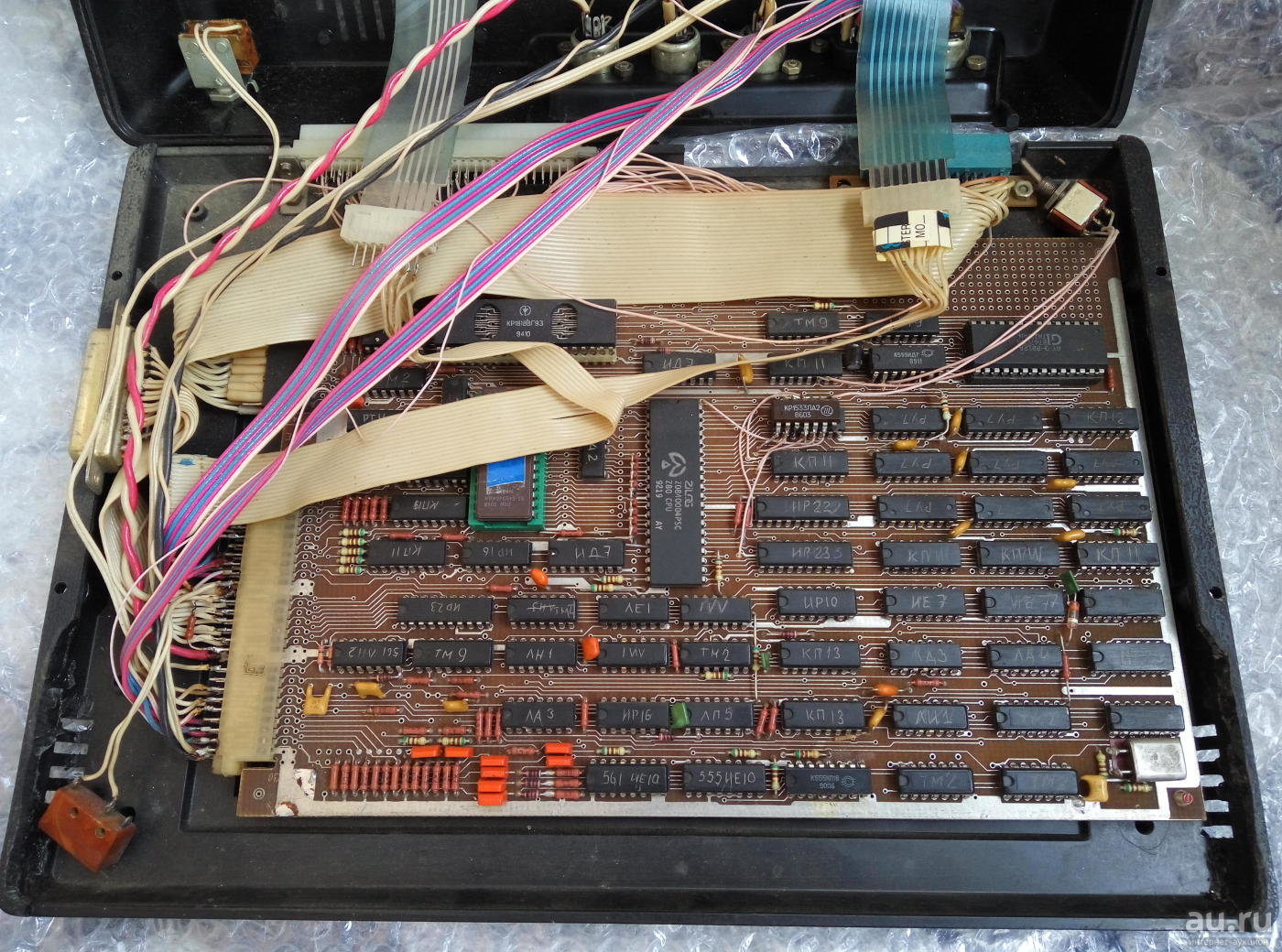
/ Scorpion board, krsk.au.ru
Pentagon
Based on the "Leningrad" version of the clone. It was developed in 1989 by the company ATM and the creative team of MicroART. Gained popularity not least because of the well-developed scheme and many ways to improve at home. Among the improvements:
- RAM expansion up to 4 MB;
- the ability to connect Covox;
- several additional video modes and multicolor;
- the ability to connect a hard drive via the Nemo IDE controller
- turbo mode.
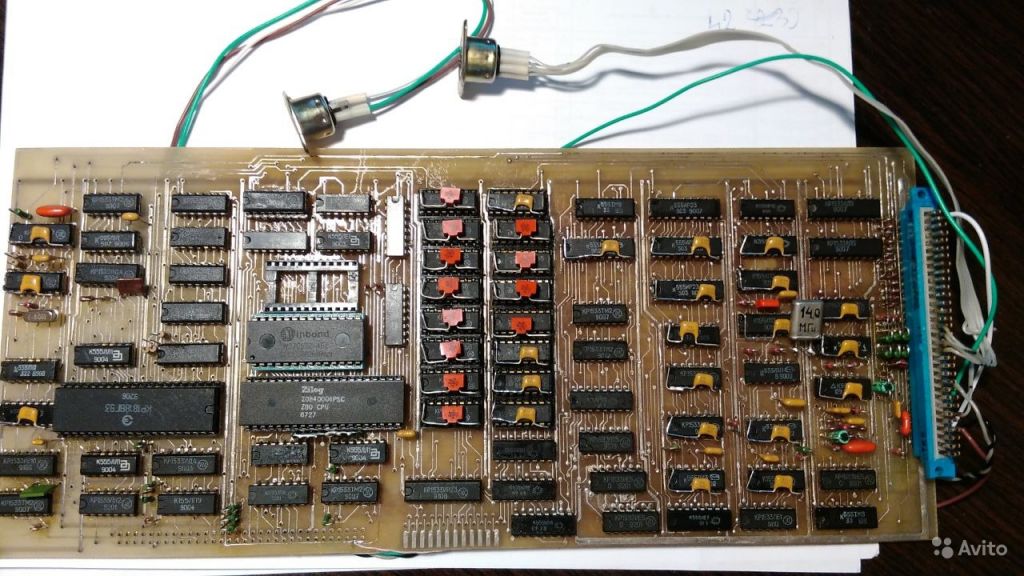
/ ATM Turbo is considered to be the Pentagon’s spiritual successor - much more complex and sophisticated.
ATM Turbo 1 and 2
One of the iconic Spectrum-compatible computers. It is the direct heir to the Pentagon clone created by the same development team. It was released in 1991. The first computer model contained a number of errors and was incompatible with some earlier software. For this reason, she did not receive much love and popularity.
The new version of ATM Turbo 2 (and version 2+, released a little later) had a number of improvements and innovations. Talking about each version separately hardly makes sense, therefore, we list the most interesting and significant features of ATM Turbo 2:
- processor turbo mode up to 7 MHz;
- RAM up to 1 MB;
- OS CP / M support (built-in ROM);
- full compatibility with original ZX Spectrum;
- a palette of 64 colors (up to 16 at the same time);
- modem (removed in version 2+);
- Support for IDE devices (HDD, CD-ROM).
Using a modem, ATM Turbo users could potentially access the network using special utilities (for example, ZX-Terminal for DialUp). Nevertheless, we failed to confirm or refute the operability of this decision, as well as obtain eyewitness accounts.
ATM Turbo 2+ is by far the most enthusiastic ZX Spectrum clone. We recommend that you familiarize yourself with this site, which contains a huge collection of programs, OS and circuits for ATM Turbo.

/ ATM Turbo 2+ board, ruecm.forum2x2.ru

/ Screenshot of the game “Little Humpbacked Horse" for ATM
Profi and Profi Plus
It was developed in 1991 in Moscow by the Condor company. It had full compatibility with the original Spectrum (switching the “Pro” and “Spectrum” modes with a special toggle switch). One of the most advanced domestic clones. Had the following features (in version 5.02 and above):
- turbo mode 7 MHz;
- RAM up to 1 Mb (used as an electronic disk);
- work in the CP / M OS in the expanded graphic mode 512x240px;
- a palette of 256 colors (up to 16 at the same time);
- hardware multicolor;
- own IDE controller for working with hard drives;
- ROM 64 KB;
- Covox;
- LPT port and programmer port;
- the ability to connect a modem (in particular, it was used to access Fidonet and to organize a local network).
An extremely interesting computer supported by high-quality software developed by the Condor company. Unfortunately, at the moment there is no complete collection of system disks, as well as disks with programs and games on the Internet. Nevertheless, in early September, VKontakte appeared “Profi Computer Support Group” , where enthusiasts, some of whom participated in the development of software for Profi back in the 90s, plan to systematize information about this clone.
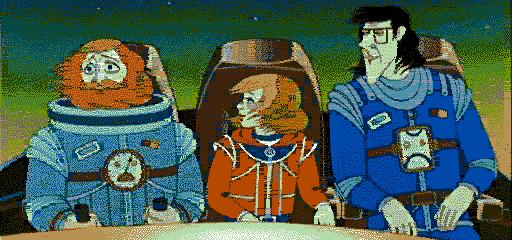

/ Demonstration of the Profi computer palette, photo from the community vk.ru “Profi computer support group”
Soft and games
In a sense, everything that was done with the Spectrum in Russia resembles pulling an owl on a globe. Of course, extremely romantic and beautiful in its own way.
One of the most common genres in games for the ZX Spectrum was platformer and isometric rpg with a bird's-eye perspective. In 2014, the Arcade Game Designer game engine was released specifically to create simple platformers. It was assumed that with its help, directly on the Spectrum or in the emulator, a novice programmer will be able to create his own game, and then save it in tap format to a computer or tape.
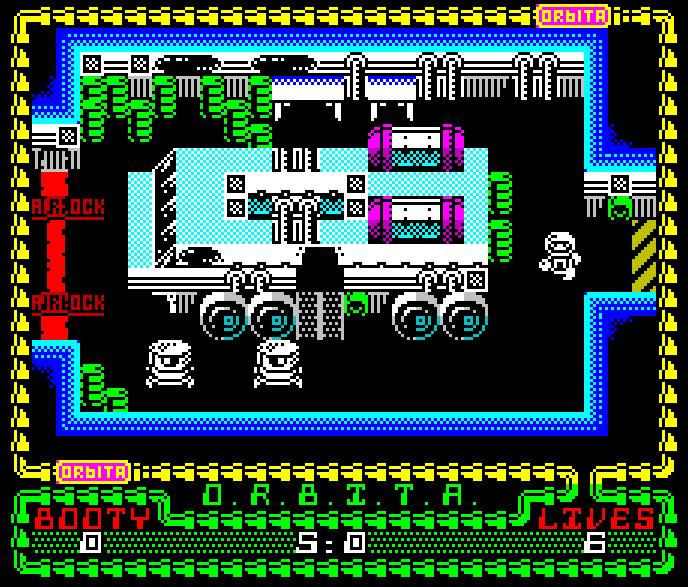

/ Screenshots of AGD games from the emulator
In the nineties, as, in general, even now, in order to create a game, it was necessary to be able to program. The simplest games were written either on the integrated BASIC or on Laser Basic. For more or less complex and interesting projects, there was only one option - His Majesty the Assembler. And here our programmers played out in earnest.
Copper feet
Surely many of those who caught the Spectrum in the 90s will recall the Adventures of Pinocchio or Black Raven, whose loading screens were decorated with the Copperfeet emblem.
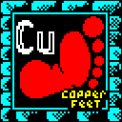
/ Copper Feet logo, photo from the Copper Feet group on Facebook
Under this "brand", only one person developed games - Vyacheslav Mednonogov .

/ Vyacheslav Mednonogov in 2005, speccy.info
Without exaggeration, he owns the masterpieces of the gaming industry for ZX Spectrum: Black Raven, ported versions of UFO and UFO 2 games, as well as some other projects.
To understand and evaluate the amount of work of a programmer is possible only by running any of these games in the emulator (or on a real machine). However, further we will provide some screenshots and links to the gameplay video.
UFO :
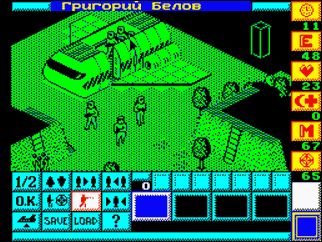
Black Raven :
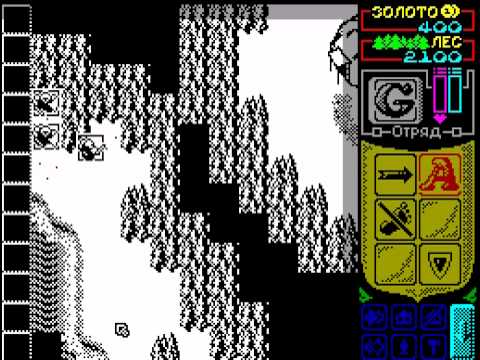
"Corporate" software and games
As a rule, they were supplied by the developers of "advanced" clones on branded diskettes.
In addition to games, there was a huge amount of application software: dictionaries, text editors, databases, system utilities, copiers, etc., that was necessary for a user whose only computer was a ZX Spectrum clone. You can now find and “feel” branded software on specific clone support sites. Below we give some of our own screenshots for Profi.

/ Proprietary text editor for Profi. I had the ability to adjust the color of paper / ink / menu and options for simple text formatting.
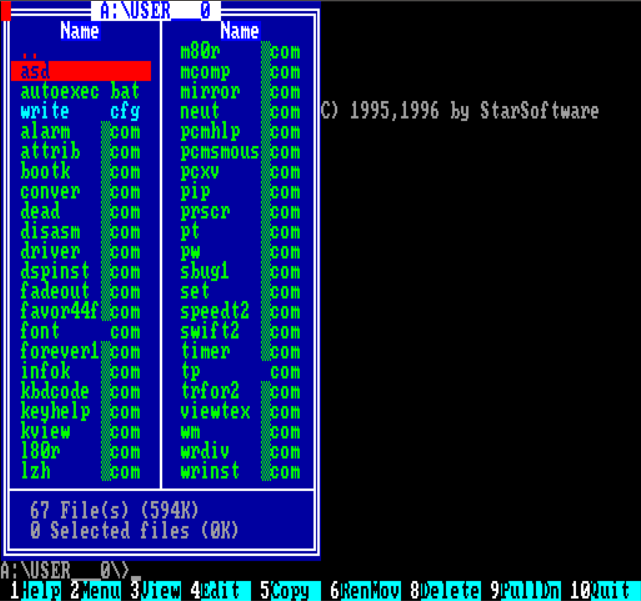
/ Dos Navigator shell for CP / M Profi OS.
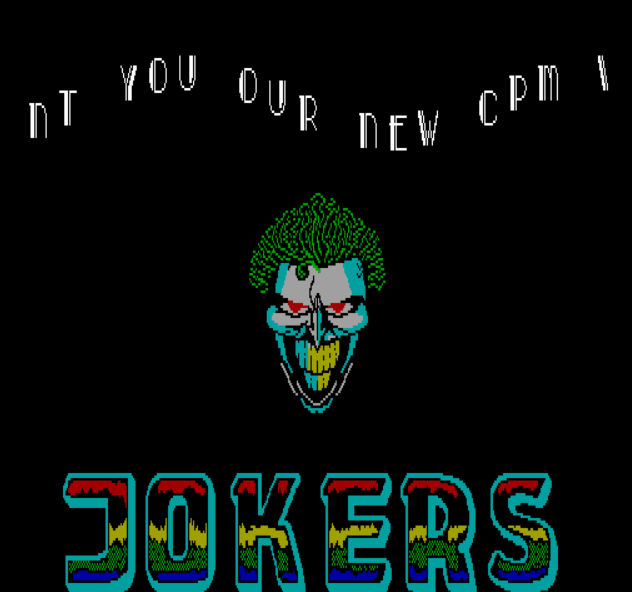
/ Logo of the Jokers group specializing in the development of games for Profi.
Internet on the ZX Spectrum: myth or reality?
Here is an excerpt from the reader’s letter to the newspaper “Passage” dated 10/14/2004, the author’s spelling and punctuation are preserved.
“What surprises me is that everyone speaks with one voice that all this is real - ICQ, IRC and even browsers. <...> There is already a TCP / IP stack, ppp dialer, but this is not enough for full access to the global network.In fact, it is impossible to speak with full confidence about the lack of “Internet” on the Spectrum. Yes, of course, the platform is not the most suitable: the low power of the processor and the difficulty in creating a “compatibility layer” between the computer and the big Internet also affect it. Nevertheless, there is evidence that even 25 years ago, the owners of "advanced" clones could, albeit with restrictions, access the network from their machines.
<...> In my opinion, at the moment it is quite possible to write at least ICQ and IRC clients - this is more than real. You ask why all this is necessary? The answer suggests itself ... I am more than sure that there are many people for whom the Spectrum is still the only available platform - at least ZXNET, which still exists, speaks about this. If once all of the foregoing is implemented, then this will allow the spektrumists to quickly communicate with each other without resorting to the help of other platforms. And perhaps it will partly stop the outflow of people from our platform. ”
Quote from the Profi Computer Support Group, user Alexey Tarasov:
“On the Pro there is all the necessary software to access Fido. Actually, from my Profic, I first went online. Unfortunately there is no normal mail editor. But then again, Write3 came to the rescue in many matters. "The existing package is tuned to modem communications through a 9600 comport. Which is currently causing significant difficulties."
In addition, Profi computers connected to a local network were located in the Condor's showrooms in Moscow on Sayanskaya Street.
In addition, there was a non-profit telecommunications network spektrumistov ZXNet. It was originally built in Moscow in 1995 as a network of stations (BBS). These stations allowed you to read and write files, as well as communicate with the operator in chat mode. Correspondence was carried out by creating specially named files. It was also mastered the automatic forwarding of messages from ZX-Net to Fido and vice versa.
Read more about ZXNet here .
If you have any information about the ZX Spectrum software that existed in the 90s and provided access to the network, we will be glad to see your comment.
Through thorns to online
The end of the 80s and the first half of the 90s in our country and in the post-Soviet space can be described as follows: we want powerful computers, communicate and develop, and we will do it from Spectrum.
Something happened. Something - no.
However, Joel Schatz’s basic message - to communicate freely - was heard. Spektrumists from all over the country communicated, exchanged experiences, gathered together to watch fresh demoscenes at any cost, even if in order to arrange a meeting, you had to use an IBM PC.
Printed and electronic versions of magazines came out. On all the radio markets of the country were sellers of pirated cassettes with games and software.
The most desperate engineers and programmers united in small firms and sold Spectrum clones to users.
People with a soldering iron found people with microcircuits to search together for those who can make boards on the “military” textolite.
Even if we take it as an axiom that there was no real Internet on the Spectrum, he fulfilled his mission of uniting people who were searching online.
What is going on in 2019?
If you have never previously encountered the Spectrum or saw it only in childhood, you may not know what is happening in its community.
It is still alive and numerous. As a hobby, thousands of people continue to use the Spectrum: someone moved to the original British cars, someone shakes off the dust from the clone of his youth. Someone even buys "remodels."
A couple of dozens of games are released annually. Most of them, of course, look the same, but diamonds also come across.
Someone is developing new technical solutions.
All this in total does not allow ZX Spectrum to be forgotten. People continue to communicate, and the computer lives on.
Finally, as a small addition to the article, here is a short list of links to interesting projects from the ZX Spectrum universe.
- ZX Evolution is an advanced and modern clone of the ZX Spectrum. Sold as a designer or as a fully finished board. Actively supported by software.
- ZX Next - a promising project that appeared on Kickstarter. Its task is in many ways similar to Evolution - to create Spectrum at the "maximum speed", convenient for the modern user. It is noteworthy that the design of the case is made by the same person who at one time created the appearance of the original.
- ZX-PK.RU is one of the largest Russian-language forums on the topic of ZX Spectrum in all its manifestations.
- ULAX is a promising piece of hardware under development that can finally defeat Spectrum caching. It is in beta test so far and is available as an emulator. The release date is not reported.
- Games from Sanchez and the team are great, modern games for the ZX Spectrum and compatible machines. The author does not have a site, but finding games is easy.
- Denis Grachev's games are interesting and original games. There are projects in multicolor that are not compatible with all clones.
- The sinc LAIR channel on YouTube is a good channel about the ZX Spectrum.
It is impossible to grasp the immensity, and this was precisely the history of the ZX Spectrum in the USSR and in the post-Soviet space. If you have any additions to this topic, we will be glad to hear your stories and comments.